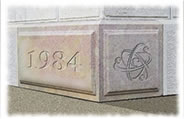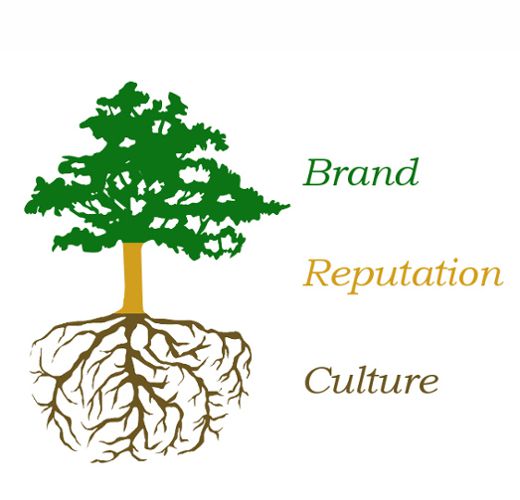Brand Scam
“It takes 20 years to build a reputation and five minutes to ruin it. If you think about it that way, you’ll do things differently.”
— Warren Buffet
“What if we spent as much maintaining or enhancing our Culture as we spend on our so called ‘Brand?’ Culture influences and infuses Reputation. Brand is fed by and floats above Reputation — a mere After Effect.”
— Jennifer R. StJohn
Fortunes are spent every year on “Re-Branding!” New logos, advertising, crested shirts, business cards, PowerPoint templates, social media, signage, literature and promotional swag. How much do we spend on Culture?
“Brand” is highly visible and powerfully seductive, but ultimately insubstantial, and amounts to what your advertising says about you…
Reputation on the other hand, is invisible, completely ephemeral; but is the substance behind repeat engagements and pass-along commitments from person to person, and generation to generation. It constitutes value beyond price — all of it fed by a Culture that prizes value and quality in each interaction. You can’t control your reputation, merely influence it. The brand belongs to the marketplace.
What you can control is your Culture, which aggregates into Reputation — through every interaction with the community, the suppliers, the employee base, and each and every customer. You control the character and the quality of those relationships (if you choose to make them relationships…)
If this sounds paradoxical, welcome to the Zen Truth of the “Value of Emptiness.” You don’t own, manage or control the Brand! Your customers (or ex-customers) do! They talk about it, evaluate it; constantly revise their considerations, and all beyond your control.
Culture, reputations and brands all trade on the making and keeping (or breaking) of promises. The sales side of the organization is chiefly concerned with the organized, structured and coordinated making of institutional promises. The service/manufacturing side is all about keeping those promises. Whatever you actually do, you’ll end up with a reputation. And, eventually, a brand. If you keep the promises — they’ll both be assets.
Now, here’s where the equation can get ugly… It costs a great deal to maintain a parts inventory. Also a good deal to keep a senior diagnostics guy with twenty years experience on hand in the service department. Recently, “value engineering” has become part of the new management vocabulary… As in Value Engineering the expense out of supply chains and staffing models. Getting rid of the Parts Department and instead, ordering replacements one at a time as a job requires them… Or getting rid of that experienced hand and replacing him with two newbies, a computer and a manual. The saved investment is significant! Hence the process catches on as shareholders applaud the returns.
But how much reputation is lost to the slow burn in the customer community as they are forced to wait for that part that hasn’t come in, or having to explain for the fourth time to the new guy the problem with your “best-engineered” car? In prior years, the parts were in stock, and the auto repair veteran could identify you and your car on sight and diagnose the fault by the engine noise. The new guy is cheaper, and the 2nd day air re-supply eliminates the entire parts inventory — all on the back of customer satisfaction — and lost reputation. The promise was made — and in prior years, kept! But now, there’s money locked up in the system which the “value engineers” hope to “free up…”
Once the “value engineering” begins, things may appear the same, but the quality has degraded. There’s nobody on the other end of the customer support line any longer, the parts are now in Buffalo… The “engineers” are spelunking in the subterranean depths of the firm, extracting all the ore, every particle of value. That imposing front grille — once a wonder of hand craftsmanship, is now “forged” of plastic. The tires don’t last so long, the paint wears off faster. The money once spent on keeping the promise, has long since found its way out of the organization. The business has become a hollow contraption… The promise makers, however, are still in high gear; pumping the brand and making sure the money keeps coming in — as long as it lasts…
The disparity between making and keeping the promise is what allows an entire generation of owners and management to get theirs and get out before they get noticed. The dirty little secret of the Brand Scam is that it happens in slow motion. It may take a decade or more for enough people to become sufficiently disillusioned to abandon the brand.
When you begin “value engineering” your culture, the reputation declines — and the brand suffers. There’s a big difference between pursuing immediate profit and incrementally building culture, reputation and an unassailable brand. When you warp your culture around false value engineering, you single mindedly destroy your reputation incrementally… Conversely, when you put the value back in the culture, the reputation improves, and the brand slowly and consistently gains in value!
If your reputation devolves down to a series of mere interactions, well, there goes the brand… The car may be great, but if the relationship is hurting; so is the brand.
And you can keep the crested shirts…
Applications
1. Personally
Certainly a person is subject to the same reputation/brand issues as a corporation. On this smaller scale, Character is at issue. That’s culture on an individual level. It’s pretty much your only asset. Character you can control, reputation is what people think and say about you. Watch what you say, present, do and deliver. It adds up and congeals into something that precedes you. Does your appearance align with your social media profile? So why not lay the base? Be on time, sober, professional and dedicated. Then dress it up and let the word spread. More work and pay will come your way.
2. At Home
You can be the family that everyone relies upon. The people who show up. The ones who are quiet but constant. You’re there for each other, and the community. Or not. And all that becomes your reputation. It starts with the accumulated interactions of seniors and juniors — all influenced and modeled by you as an individual. So, build a reputation upon your family culture created and maintained by you as a parent, one positive step at a time.
3. At Work
If you’ve got a good reputation, then you have the luxury of promoting a brand. But just get the steps in order. Bill Bernbach* said “Nothing kills a bad product faster than great advertising!” So build the cultural foundation first, and never stop. The reputation will take shape, solidify and become something of value. Then go to work on the quiet, solid, low key process of marketing, selling and yes — even advertising — to widen your reach. The customers will build the brand.
Culture is a case study in The Value of Emptiness… The Great Reputation derived from solid culture is yours to build or break. It’s ephemeral, but powerful. It builds up, and becomes a Brand… But if the reputation is gone, the “brand” is nothing but gossip.
There’s a lot of bad air out there because of the Brand Scam. Noise! Advertising! Confusion! And millions spent getting the cart before the horse. Your creation however, can be different, special, unique. Built on the foundation of a solid culture, giving substance to a reputation which can ultimately benefit from a little nudge and help the customers create the Brand.
* “The legendary William (Bill) Bernbach (August 13, 1911 – October 2, 1982) was an American advertising creative director. He was one of the three founders in 1949 of the international advertising agency Doyle Dane Bernbach (DDB). He directed many of the firm’s breakthrough ad campaigns and had a lasting impact on the creative team structures now commonly used by ad agencies.” —Wikipedia
Subscribe to our Newsletter


